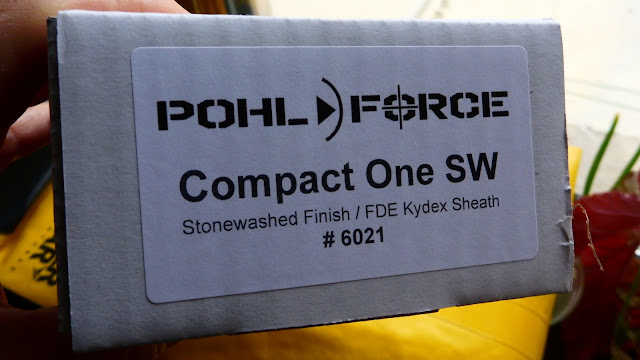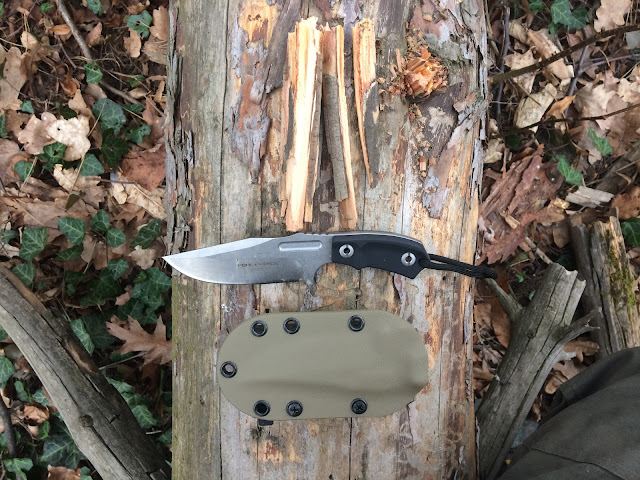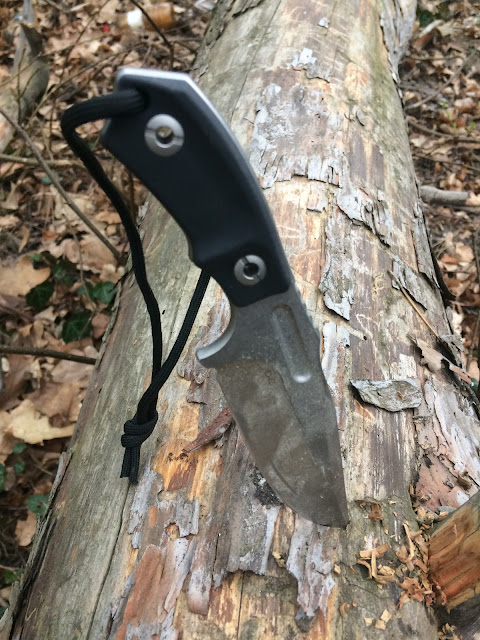Six randomly grabbed knives, they all sport different tip designs and if I grab another 6 from the bag, then these will also be different!
WHAT'S THE POINT????
by BCT
Recently a subscriber asked me to make a video on the different knife tips out there and discuss their usefulness.
So in order to make that video I first thought I'd write something about it here:
There are so many knife designs now they have basically come full circle, in that designs are copying designs and those copied designs can usually all be found with some ancestors sitting behind glass in museums around the globe!
Certainly this is my experience. However, for a knife to of any practical purpose it foremost must be able to cut well and have a point in order to penetrate. Anything after this is just a bonus (if correctly designed!).
For example: In the latter case we may see the addition of serrations; a choil; gimping; swedge; saw; line cutter; wire breaker etc etc. Following this we may see some sort of what I call "funky blade design" almost always but not exclusively, in order to market the knife-usually (but not always) to the uninitiated.

Saw back knives are an option although not "everyone's cup of tea"!
Nor are serrations although i would argue serrations are mandatory for any serious outdoor knife.

Is it possible to have a thick chunk of steel that cuts well? Yes this is possible but to to take this idea further we need to define what we mean by cutting and cutting exactly what? Because cutting ropes is one thing but cutting up your camp meal is another.
In general knives which are too thick close to the edge will make cutting up rigid foods a bit difficult. (eg hard tuberous vegetables.).
Clean cuts as in slicing is very difficult with such blade design as above, which is great for chopping and cutting but not slicing through vegetables or fruits. Note the almost broken surfaces of the onions.
Can one knife do it all? Of course not.
Different surfboards for different waves.
Now just because it cuts well does not mean it is easy to sharpen. Anything other than totally straight edges will always require somewhat more skill to learn to sharpen than only straight edges, fact. Any blade which has a portion of it's design as a recurve, ie the blade curves inwards, will provide a more challenging surface to keep sharp. For example but again not limited to:

The mighty Cudeman, super thick spine 299B Biona Verde. Tactical as but hard to sharpen with just one type of abrasive due to the irregular blade edge. Since this picture was taken I have further modified the handle as I felt it was not really all that ergonomic for my hands. The ONLY reason this knife works is that it has a hollow grind otherwise putting a flat grind on it just wouldn't work. (N695).But do not think it is a chopper because it isn't. Why? Because of the hollow grind, it's a thin blade profile and only penetrates well but does nothing to force out the cut wood, unlike the thick profile of a hatchet or axe. This is a knife for cutting ability and bashing things with the thick spine.
The easiest edges to maintain are by far those which are basically straight. here we see the Fulcrum S from Extrema Ratio which has only 2 straight edges. (N690) or the Mighty Big Brother of the Fulcrum S, the Extrema Ratio FULCRUM (this model in Desert camouflage), a very capable knife which is definitely in the "survival class". More on this model a little later.
For a super easy way to keep the edge keen I use a black marker pen and 1500 grit/grade Silicon Carbide paper resting on a neoprene mouse mat. Dragging not pushing in this case.
Marking the edge with a black marker pen allows one to see how even their strokes are and that they are actually sharpening the blade and NOT BLUNTING IT!

The quintessential "DROP POINT" as seen in my LionSteel M7 an iconic product from LionSteel in Italy. One curve and one straight edge. (Sleipner tool steel). This is a big knife but in reality a small cutting edge. The point is good enough for hunting but the knife in reality is to heavy and big for long arduous tasks, such as skinning. However, it excels at processing big fish!
Another iconic blade, the AITOR OSSO BLACO (OLIVIO-this just means it has a Olive wood handle), featuring a generalist Bowie design with pronounced recurvature of the blade in a semi hollow grind. Time consuming to sharpen but thanks to the quality steel, it stays sharp for a long time even with hard use. (Aitor proprietary stainless). If one sharpen the upper swedge then it is great for gutting fish. As one can see it has a very pronounced tip.
Let's discuss what "Multipurpose" could mean?
When I hear this terminology, I think of the following (but not limited to):
Prying
Stabbing
Cutting
chopping
Hacking
Drilling (with the point)
Diving (if you have to-therefore to satisfy this criterion it must be made from stainless steel)
Used as a foothold to gain height
etc.
I do not think of fishing or hunting when I read "multipurpose".
However, a true multipurpose knife MUST feature a sharp point tip: here is a good example, sharp pointy tip, robust design and also featuring serrations.
However, can such a knife which satisfies the above be ok for some outdoor pursuits? (if you had to?)- it's a bit like taking a mountain bike cycle touring when one might be better off with actually taking a hybrid bike with panniers (been there done his many times with both types of bikes-in a later blog for sure!).
The answer, could be yes (dependent upon circumstances).
Let's say one was going to hike some rugged coastline, supplement their dietary needs with some fishing and maybe even some impromptu diving along the way. Planning also to light some fires if wood is available? My experience in such adventures is that even on THE most remote beach, ocean currents and tides providing-(Know your prevailing currents and tides) lots of rubbish gets washed ashore, including pallets and natural drift wood.
Pallets can be plentiful on some beaches (such a shame) but are very difficult to bust up by hands alone. Being able to prise them apart can really help out with using them for fire wood. This requires either a stout machete, parang or a very stout knife.
There is no reason to take a stainless steel knife diving which has a synthetic grip which will soak up the sea water. That means Micarta is OUT! Kraton and Forprene are good, G10 possibly depends upon the finish.
Being able to thoroughly clean a knife after dunking/swimming in the sea is a must. Can you remove a grip/scales without specialist tools?

The very strong (but not indestructible) Extrema Ratio Fulcrum S being used to lever off a hardwood plank on a wooden bin.
This type of blade profile can be sharpened with basically anything from some carbide paper to dedicated sharpening instruments.
Now that that is out of the way, let's discuss knife tips.
When I think of outdoor knives I think of knives primarily used for preparing food. For me a knife must also be sharp, not necessarily deadly sharp but sharp enough to cut through fish skin (a good test). If you are considering hunting and fishing then a big thick blade will not be as useful as thinner (5mm and under) for hunting and fishing. The shape will play a big role too in how comfortable or practical it will be to use over a long period of time.
Can hunting (specific) knives be any good for also around the camp?
Answer: of course! But it depends upon if you are camping and hunting or you walked in and are camping because if you are camping not10 yards away from your vehicle, then you can indeed bring the "Kitchen sink" and any argument about what knife is best becomes irrelevant. If however, you are walking in then "less is always best" anything else is BS!
Here is a knife which will serve you well for hunting and also preparing all food around the campsite.
There is nothing I can not do with this knife for hunting up to medium sized game (large wild goats/pigs) to preparing the evening meal around the camp at the end of the day; all with the same knife! The LINDER Super Edge 2, with a tip shape very close to that of a butcher's knife profile.Here is another great hunting knife from FOX (N690).

What about hacking down a tree to cross a swollen creek? Is this a reality? I would say this can be. I have been in situations where I wanted to cross a swollen mountain stream, too cold to get wet (ice melt) and too foolish to get wet or worse fall over whilst crossing it. One may need to fell some small saplings, without an axe or saw this can be difficult with only a lighter knife.
You're going to need to carry a bigger knife (or saw or hatchet)
My FOX (FKMD) PARUS, designed for light chopping and cutting! (believe it or not!). Pair this knife with a folding saw (if you have the room) then you will be set for some adventures off the regular track/paths (if permitted).
What about a Clip Point?
For example, you might think that a clip point blade would be ideal for a hunting knife to do skinning and it certainly has a good point in order to start cuts but in reality they suck at this because the tip curvature is not enough to put your hands in a comfortable position and the tip is just too pointy for fast skinning. Thus trying to use a clip point blade for large jobs skinning (especially if you don' want to accidentally puncture the hide) can be very uncomfortable- I know i tried this, there is simply not enough "belly".
For an experiment, once as a test, I did indeed bring 2 knives on a bowhunting trip, a PUMA hunting knife and my trusty (but not for hunting) Ontario Spec Plus- a pronounced "clip point'
Trying to skin with it nearly buggered my wrists and eventually gave up and went back to my dedicated hunting knife (PUMA Hunter's Friend-made in 1974!).
For skinning, one wants their hands to be as close to the hide as possible for the best control in order not to accidentally pierce the hide. -In general- hence good skinning knives have a largish belly region and may be part of a pair of knives used to dress out your game and they are generally not very long for better wrist control and less fatigue. (Note the longer the blade the grater the leverage is-but in a reverse order- you don't want this for skinning.
Fishing is a different matter as a good knife here must without any doubt have a good point tip in order to start at the vent to gut the fish.
The tip should be one of the sharpest regions on the blade along with the area closest to the ricasso IMHO.
BIG BIG CHOPPERS
Sure, big choppers such as this beast from WorktuffGear, the Nomad, (Japanese SK85 tool steel) can indeed prepare food, possible hunting and fishing and cutting open (but not down off the tree-it's too short) coconuts. But it is heavy! Fine for a vehicle or some sort of transport.
Two variations of the "tanto" wakazashi style blade as seen in these two fixed blades from Extrema Ratio. The blade in the lower image can also be used for "push cutting' and is actually a very versatile knife from ER. Note the difference between these 2 tanto type tips, the lower one having a slight curvature, the upper one being totally straight, hence the lower one necessitates some skill to maintain the slightly curved edge.
You can slice with such a knife!
"Drilling" a divot into hardwood is not a problem for these Extrema Ratio Tanto tipped knives- seen here the Fulcrum NFG "drilled into" dead and seasoned Elm tree log.
A drop point with a tip swedge will always help for penetration but better if the swedge is sharpened! The Kizlyar Supreme Dominus, a superb no nonsense highly durable tactical knife in AUS8 stainless. It also comes with a very tactical scabbard carry system.
A most excellent knife the LINDER SUPER EDGE 5 (seen in the above 2 images, made with genuine Japanese Hitachi ATS-34 stainless). This knife has an excellent tip.
Heavy (in the handle-i does have a glass breaker end, so this makes sense), almost indestructible but thin enough for preparing food. Military intended, the Spirit Soldier from RAIDOPS (Böhler's D2) can do the job if one isn't concerned about weight. However, neither of these two above knives are any good for hunting. The LINDER SUPER EDGE 5 though is just fine for fishing, the Spirit soldier can be used but overly heavy.
Another big boy "survival" knife, the Kizlyar Supreme Survivalist fixed blade, my model in AUS8. At 5mm thick it reaches a good compromise, easily hack open coconuts to preparing evening meal, or chop a palm down for food.
Big knife, big adventure. Extrema Ratio AMF. THIS is NOT a general camping and hunting knife, this is for going outback for some time. Or up that mangrove, crocodile infested river but with "a paddle" LOL! (make sure it's tied on so you don't drop it overboard!)
The Extrema Ratio TASK J, (N690) made for the Austrian military commandos. A truly well-thought out combat/survival knife. But again , not a hunting knife for "living off the land" (although fishing for food is good). This has a sort of "sheep's foot tip, very unusual for a fixed blade and more commonly seen amongst older style folders. The upper edge is sharpened and this type of tip provides a very effective penetrating knife. The blade requires some skill to sharpen because it is entirely of a convex shaped edge. It is an incredibly strong design bordering like the spirit soldier on being indestructible, although as Extrema Ratio like to say, no knife is indestructible including theirs!
Finally, on this note I'd like to point out that indeed no knife is indestructible and should one find themselves erring on the side of abusing their tools, then you should consider the consequences of what situation you might be in if you break it and readjust your behaviour towards your knife (or any tool for that matter).
Addendum: Don't get too hung up** about the knives (or brands) I used in the above examples, they were just what were on hand at the time of writing this article. If I chose again there would no doubt be another different bunch of knives from "out of the bag" so to speak. I just wanted to emphasise the differences in tips and functions as I see it. I'm sure all of you have your own views here based upon your experiences and they of course could/would be totally different to mine.
**So basically what I'm trying to say here is, don't get political on me. This blog and channel I strive to keep "non political" over the years. There are countless blogs and channels out there discussing similar topics with political slants, this is not one of them.
BushCampingTools
updated on the 6/3/2022
2022
s once as a test, where I did indeed bring 2 knives, a PUMA hunting knife and my trusty (but not for hunting) Ontario Spec Plus-
nearly buggered my wrists trying to skin with it and eventually gave up and went back to my dedicated hunting knife.
For skinning, one wants their hands to be as close to the hide as possible for the best control in order not to accidentally pierce the hide. -In general- hence good skinning knives have a largish belly region and may be part of a pair of knives used to dress out your game.
Fishing is a different matter as a good knife here must without any doubt have a good point tip in order to start at the vent to gut the fish.
The tip should be one of the sharpest regions on the blade along with the area closest to the ricasso IMHO.
whilst a clip point





























































